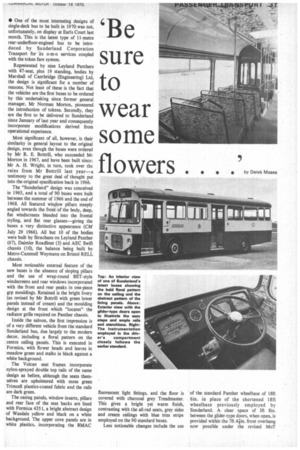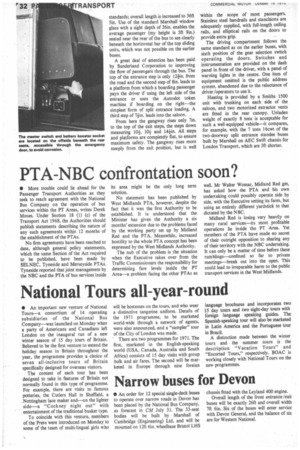sure to wear some flowers
Page 33

Page 34

If you've noticed an error in this article please click here to report it so we can fix it.
• • • • by Derek Moses • One of the most interesting designs of single-deck bus to be built in 1970 was not, unfortunately, on display at Earls Court last month. This is the latest type of 11-metre rear-underfloor-engined bus to be introduced by Sunderland Corporation Transport for its o-m-o services coupled with the token fare system.
Represented by nine Leyland Panthers with 47-seat, plus 19 standing, bodies by Marshall of Cambridge (Engineering) Ltd, the design is significant for a number of reasons. Not least of these is the fact that the vehicles are the first buses to be ordered by this undertaking since former general manager, Mr Norman Morton, pioneered the introduction of tokens. Secondly, they are the first to be delivered to Sunderland since January of last year and consequently incorporate modifications derived from operational experience.
Most significant of all, however, is their similarity in general layout to the original design, even though the buses were ordered by Mr R. E. Bottrill, who succeeded Mr Morton in 1967, and have been built since: Mr A. H. Wright, in turn, took over the reins from Mr Bottrill last year—a testimony to the great deal of thought put into the original specification back in 1966.
The "Sunderland" design was conceived in 1965, and a total of 90 buses were built between the summer of 1966 and the end of 1968. All featured window pillars steeply angled towards the front of the body, deep, flat windscreens blended into the frontal styling, and flat rear glasses—giving the buses a very distinctive appearance (CM July 29 1966). All but 10 of the bodies were built by Strachans on Leyland Panther (67), Daimler Roadliner (3) and AEC Swift chassis (10), the balance being built by Metro-Cammell Weymann on Bristol RELL chassis.
Most noticeable external feature of the new buses is the absence of sloping pillars and the use of wrap-round BET-style windscreens and rear windows incorporated with the front and rear peaks in one-piece grp mouldings. Retained is the bright livery (as revised by Mr Bottrill with green lower panels instead of cream) and the moulding design at the front which "locates" the radiator grille required on Panther chassis.
Inside the saloon, the first impression is of a very different vehicle from the standard Sunderland bus, due largely to the modern decor, including a floral pattern on the centre ceiling panels. This is executed in Formica, with flower heads and leaves in meadow green and stalks in black against a white background.
The Vulcan seat frames incorporate nylon-sprayed double top rails of the same design as before, although the seats themselves are upholstered with moss green Trimcell plastics-coated fabric and the rails are dark green.
The casing panels, window inserts, pillars and rear face of the seat backs are lined with Formica 4351, a bright abstract design of Wasdale yellow and black on a white background. The upper cove panels are in white plastics, incorporating the BMAC fluorescent light fittings, and the floor is covered with charcoal grey Treadmaster. This gives a bright yet warm finish, contrasting with the all-red seats, grey sides and cream ceilings with blue trim strips employed on the 90 standard buses.
Less noticeable changes include the use of the standard Panther wheelbase of 18ft 6in. in place of the shortened 18ft wheelbase previously employed by Sunderland. A clear space of 3ft 8in. between the glider-type doors, when open, is provided within the 7ft 4iin. front overhang now possible under the revised MoT standards; overall length is increased to 36f1 5in. Use of the standard Marshall window glass with a sight depth of 26in. enables the average passenger (my height is 5ft 9in.) seated near the rear of the bus to see clearly beneath the horizontal bar of the top sliding units, which was not possible on the earlier buses.
A great deal of attention has been paid by Sunderland Corporation to improving the flow of passengers through the bus. The top of the entrance step is only 12iin. from the road and the second step of 8in. leads to a platform from which a boarding passenger pays the driver if using the left side of the entrance or uses the Auto slot token machine if boarding on the right—the simplest form of split entrance loading. A third step of 7iin. leads into the saloon.
From here the gangway rises only 7in. to the top of the exit steps, the steps down measuring 10+, 10+ and 144-in. All steps and platforms are completely flat, to ensure maximum safety. The gangway rises more steeply from the exit position, but is well 'within the scope of most passengers. Stainless steel handrails and stanchions are adequately supplied, with full-length ceiling rails, and elliptical rails on the doors to provide extra grip.
The driving compartment follows the same standard as on the earlier buses, with sixth position of the gear selection switch operating the doors. Switches and instrumentation are provided on the dash panel in front of the driver, with a panel of warning lights in the centre. One item of equipment omitted is the public address system, abandoned due to the reluctance of driver /operators to use it.
Heating is provided by a Smiths 1500 unit with trunking on each side of the saloon, and two motorized extractor vents are fitted in the rear canopy. Unladen weight of exactly 8 tons is acceptable for such a well-equipped vehicle—it compares, for example, with the 7 tons 16cwt of the two-doorway split entrance standee buses built by Marshall on AEC Swift chassis for London Transport, which are 3ft shorter.
























































































































